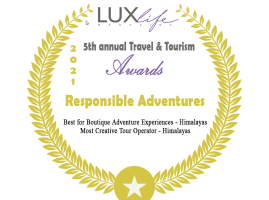Ghantakarna Chaturdasi Festival of Nepal
This festival is generally celebrated in July/August. However, this year it was on the 30th of July 2019. Since the beginning, people have given ‘peace’ offerings and sacrifices to demons, serpents, supernatural beings, and natural elements such as water, fire, and the wind.
Legend has it that a demon named Ghantakarna was a notorious demon who was known to spread havoc amongst the people. Therefore, this festival is to remember and celebrate the end of Ghantakarna.
Effigies of the demon are erected at the crossroads of all the streets. People place pots of cooked rice at all intersections for the beast. A man coloured in black and blue paint all over his body goes around begging for money. The demon’s effigy is dragged to a nearby river to get rid of the painted man sitting on it. People offer the model of demon meat and other food today; people also wear metal rings known as Gathemangal ko aunthi (Gathemang’s c. It is believed that this ring safeguards people from all evil spirits. In addition, the locals hammer three-pointed nails onto the doorposts to keep the evil at bay before nightfall. As usual, several legends and myths are connected to this demon, Ghantakarna, which is part revered and part feared.
The children make the effigies of Ghantakarna out of bamboo, tree branches, and dried corn stalks. The children collect money from passersby in the name of Ghantakarna. The children shout and call those who refuse to give money, “look at the grandson of Ganthe Mangal; he is coming!” This day also marks the beginning of the month-long Lakhe Naach (Mask dance)
In the past, when water scarcity or thunderstorms brought illnesses such as gastrointestinal problems, common during the monsoon period, people believed that evil spirits were behind the diseases. They found that evil spirits could cause these diseases because of the absence of The Nine Durgas (Nava Durga).
People do these things on this day.
- Cleaning of the houses
- Enacting the mythical drama in the streets
- Make effigies denoting Ghantakarna and place them at the crossroads of every main street.
- Girls hang their hand-made dolls on this effigy to protect themselves from evil spirits.
- People wear a wrought iron ring on their fingers and ornaments made of silver or gold on their children’s wrists and ankles.
- Girls apply henna to their palms.
- Groups of boys roam, asking for alms shouting ‘Aaju Jaya Haa, Om Shanti Jaya Nepal.’ The collected money was used for the ritual works for their deceased family members in the past.
- Locals gather to erect the effigy, and a monster-like drawing is painted on it.
‘Aaju Jaya,’ the one who impersonates Ghantakarna by smearing himself with paint, is served beaten rice with curd under the puppet.
‘Aaju Jaya’ is then made to wander the streets with a burning torch made out of the husk and begging for alms. The man goes around the effigy three times. Finally, everyone volunteers to drag Ghantakarna to a nearby river.
However, during the process, ‘Aaju’ escapes from the way.
Even though no recorded history is available of when this festival started, it is believed that it began during the Lichhavi period during the reign of the Gopala Bansha (the cowherds). Once again, there are several versions of this festival.
A slightly different version of this folklore is;
A demon called Ghantakarna, who wore a pair of bells as earrings, terrifies the people and kills them. The meaning of his name was Ghanta (bell), Karna (ears)
When all attempts to kill the demon failed, a wise frog was successful in executing this demon. The frog lured the demon into a swamp, trapped him while out hunting, and managed to kill the monster. It is said that this day of the new moon marks the celebration of the Ghantakarna Festival. This is why the Newar community worships the frog on this day.
There is also a slight confusion/controversy about whether Ghantakarna was a demon or a deity. The Hindus worship Ghantakarna as a devotee of Lord Shiva, while the Buddhists consider him a form of Bhairav.
Check out our Trekking packages for Nepal, Bhutan, India, and Tibet.
















